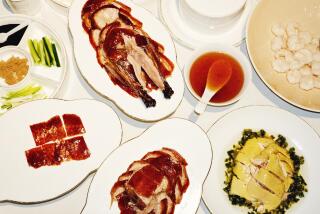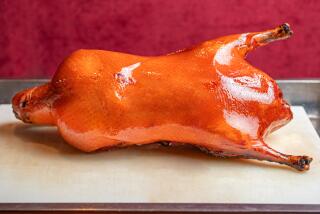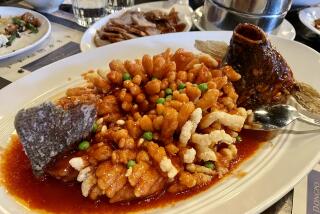A Foolproof Method for Cooking Duck: Give It a Hot Bath
Duck, with its rich, moist flesh and crisp, flavorful skin, can be the most delicious of all poultry. Then again, when it’s improperly cooked, the inside is overcooked and dry and the outside is soft and greasy.
Because I love duck so much and have been disappointed with it more often than not, even in restaurants, I set out years ago to find a way to roast duck that would eliminate the maximum amount of fat while keeping the juiciness.
The solution turned out to be extraordinarily simple: Boiling water is poured over the skin to tighten it and then the duck is air-dried (which can be accomplished overnight in the refrigerator). During roasting the skin of the duck is pierced, the oven temperature is kept very high to release the fat, and boiling water is poured directly on the duck to keep it moist and to prevent the fat from splattering. The resulting duck is virtually fat-free, with moist flesh and crisp skin. As an added benefit, it cooks in under an hour.
In the 15 years since discovering this technique, I have never prepared duck a different way. But I do have a memory of quite a different duck that was still more delicious at an unforgettable lunch in the South of France.
I was in Lyon, working with the master chocolate maker Maurice Bernachon on the translation of his book “A Passion for Chocolate.” Bernachon invited me to lunch to celebrate the book’s completion and asked me to choose between the restaurants of Paul Bocuse and Alain Chapel. I was torn. Both are brilliant chefs, but Chapel, with his near-military precision and passionate perfection, was the chef of my heart and soul, and his was my favorite restaurant in all the world.
Despite this, and after some hesitation, I chose Bocuse because I knew that Bernachon’s son, Jean Jacques, is married to Bocuse’s daughter. Politesse won out over passion--not to mention the fact that I knew we would eat magnificently at either place. And I comforted myself with the promise that someday soon I would return to Chapel.
The day of the luncheon arrived. We folded our aprons, changed out of our whites and drove off to what turned out, to my joyful astonishment, to be Alain Chapel. The greeting Bernachon received from the maitre d’ was worthy of a king. But then, of course, he is considered the king of chocolatiers in France, and his neighbors in the food establishment are very proud of him. Chapel came out to greet us and serious discussion ensued (as only seems to happen in France) about our culinary fate.
The first course arrived and from then on the meal seemed never to end. We ate for four hours, but so slowly that I had the illusion of never being full. (Afterward, though, I went to my hotel and slept for five hours. And when I awoke, I was not hungry for dinner.)
I remember best the splendid regional cheese--a Vacherin Mt. d’Or--that was at its peak, the glorious Burgundy that was the best I have ever tasted and which seemed to rise at the end of each sip like a musical note. And I remember the canneton a la vapeur , which was the best duck I had ever tasted. Chapel poached the duck in a flavorful broth and then roasted the legs to have the contrast of the crisp skin.
At some point during the course of the meal, I mentioned to Bernachon how much I enjoyed the French facial expressions known as les moeux-- how you can see in their faces exactly what they are thinking. To my surprise, his response was: “You also have a face like that.”
Finally I knew how it was that we ended up at Chapel’s instead of Bocuse’s! And a good thing too, as it turned out to be the last time. My beloved Chapel died soon after.
ROSE’S ROAST DUCK
1 (4 1/4- to 5-pound) Long Island duckling
Salt, pepper
1 clove garlic
1 apple, quartered, for flavor
Day before, remove all loose fat from duck and pour boiling water over skin. Sprinkle lightly inside and out with salt and pepper to taste. Place duck on rack suspended over pan to catch any drippings. Refrigerate 24 hours.
Next day, wrap foil around wings of duck to protect from burning. Rub duck with garlic, then place garlic in duck’s cavity along with quartered apple. Pierce duck all over with fork, being careful not to go deeper than fat layer. Pour 1/4 cup boiling water over duck and roast at 450 degrees 15 minutes. Remove from oven. Pierce duck and pour water over top again. Return to oven. Repeat procedure every 15 minutes until duck has been in oven at least 45 minutes.
Test for doneness by tipping duck tailward--juices should run almost clear. Allow to stand 10 minutes before carving. If desired, place just back under broiler few minutes to crisp skin. Discard garlic and apple. Makes 2 servings.
Note: For totally fat-free duck, make small incision in either side of duck’s cavity, approximately between where leg and thigh joints are located, and remove long strip of fat that wraps itself around top of legs.
More to Read
Eat your way across L.A.
Get our weekly Tasting Notes newsletter for reviews, news and more.
You may occasionally receive promotional content from the Los Angeles Times.










